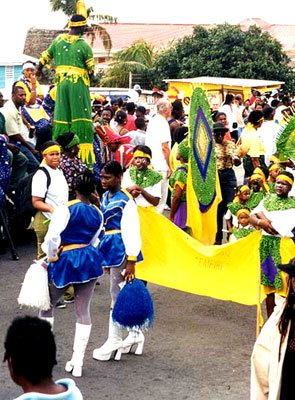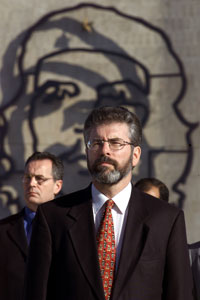|

Christmas Carnival in Montserrat
(Jonathan Skinner, 2000) |
The Caribbean was the
first American region to come to the attention of
sixteenth-century Europeans. It was here that they at
first marvelled at the pristine beauty of the New World,
were puzzled by the 'strange' Arawak and Carib natives,
lorded it over the indigenous people and their countryside
in the name of religion, civilisation, and mercantile
expansion. They thereby set in motion the largest
trans-oceanic migratory movement in the history of the
world. The pursuit of riches and fame lured enterprising
people from throughout the 'Old World,' fascinated by the
unique languages, spiritual beliefs, and cultural
artefacts of the people of the 'New World'. While it is
tempting to describe this process using modern-day
multicultural clichés like the 'melting pot' ideology of
the United States or 'mestizaje' in Latin America, it must
be remembered that intense friction accompanied the
post-1492 re-settlement of the New World.
The newcomers brought
with them their centuries-old quarrels, and these were
played out in the Antillean archipelago in the shape of
inter-imperial competition and warfare. These carry-overs
from Old World politics, in turn, would influence the
various ethnic, religious, and racial groups that came to
be a part of the re-settlement of the Americas. The
Caribbean and its surrounding littoral exemplify this
legacy. Perennial clashes between Spain, France, England,
Denmark and Holland, the five leading European countries
whose subjects carved out colonies there, have
characterised much the history of this region over the
past five centuries. Even Sweden, which at one point
occupied the tiny island of Saint Bartholomew, was
involved in these economic and territorial battles.
Although the region-wide
violence perpetrated by pirates, privateers and armed
military expeditions, who raided, pillage and killed is
now largely behind us, it has been replaced by another
type of discord: the politics of representation. The
area's present-day historiography, particularly in
relation to the colonial period, mostly focuses on the
Spanish, French, British, Danish and Dutch settlers, and
their various attempts to gain the upper hand. Colonists,
fortune-hunters, adventurers, clerics, voyagers, coerced
labourers, prisoners, religious dissidents and mercenaries
from other parts of Europe who also had a role in the
demographic, economic and political evolution of the
Antillean archipelago, are generally marginalised or
silenced.
The Irishmen and women
whose varied experiences are featured in this special
edition of Irish Migration Studies in Latin America
are certainly some of them. With the possible exception of
the Irish association with the eastern Caribbean island of
Montserrat, they are not in the mainstream of academic and
popular discussions of Caribbean Studies. It is hoped that
the essays that follow will shed some light on their
voluntary or compulsory arrival, successes and failures,
misfortunes and strokes of luck, virtues and shortcomings,
contributions and blunders, in short on their 'lived'
experiences.
Perhaps one of the most
revealing findings in this collection is the fact that the
Irish diaspora in the Caribbean was not limited to any one
historical period, group of individuals, or geographical
area. Their presence in the region stretched across time,
from the indentured servants in the 1650s to mercenaries
and freedom fighters in the early nineteenth-century
Spanish American wars of independence. Unlike many other
European colonists, who generally came as single men, one
finds both Irish men and women among the pioneers. Some,
like Byrne's John Hooke, arrived voluntarily; others
crossed the Atlantic under duress, like the transported
and forced labourers studied by Rodgers.
Most European settlers
on the islands confined themselves to one or another
island or group of islands, hence the modern-day
expressions Hispanic Caribbean, French Caribbean, British
Caribbean, and so on. The Irish, on the other hand, looked
for and found new homes wherever opportunities or other
circumstances took them. They resided on practically all
of the islands of the Caribbean and circum-Caribbean zone,
as demonstrated in the papers by Rodgers, Anderson, Power
and Chinea, among others. Some of them were undoubtedly
trans-colonial, multilingual, and highly adaptable to
changing environments.
|

Sinn Féin leader Gerry Adams at the
Plaza de la Revolución, Havana, during his visit to
Cuba on 16-19 December 2001.
(José Goitía/AP, 2001) |
The Irish also helped to
shape the demographic, social, economic and political
evolution of the areas under study. Early on, Irish
servants and religious dissidents comprised the bulk of
the white population of the British Caribbean. When the
islands made the transition to sugar cultivation, and
Africanisation set in, this numerical advantage faded
away. Since the presence of whites now became a matter of
public safety, some of the Irish exploited this shift to
their advantage whenever possible, by seeking or demanding
access to the more prestigious positions of master
artisans, overseers and planters.
In some cases, as shown
by Power, Irish people took leading mercantile positions
in the expanding world of transatlantic trade. Others
escaped from servitude or defected to England's Catholic
rivals, especially France and Spain. In Cuba, Irish
railroad workers became part of the plantocracy's
unsuccessful 'whitening' scheme, as described in Brehony's
article. Politically, the vital roles played by the
O'Reilly-O'Daly team in revamping defences in the Puerto
Rican capital of San Juan, as examined in Chinea's
article, or John 'Dinamita' O'Brien during the Cuban
insurrection of the 1890s, analysed in Quintana's article,
are also acknowledged in this volume. They are but a few
examples of a long tradition of Irish military presence in
Spain and its American colonies.
Finally, the Irish
impact in the region went beyond their physical activities
as servants, planters, merchants and soldiers. Attempts to
draw comparisons between the colonial experiences of
Ireland and the Caribbean have also sparked the creative
energies and imagination of writers. Two examples in this
volume are Tewfik's insightful deconstruction of Lorna
Goodison's poem, 'Country Sligoville', and Novillo
Corvalán's original search for a literary kinship in the
works of Derek Walcott and James Joyce. Their work shows
the enduring cultural, linguistic and political
cross-pollination resulting from the Irish presence in the
Caribbean, one that challenges the notion of discreet
colonies or nations evolving in relative isolation.
Instead, the authors show how writers in both the
Caribbean and Ireland see or have come to grips with their
common experiences with servitude, oppression and forms of
colonialism.
Jorge L. Chinea
Wayne State University |


